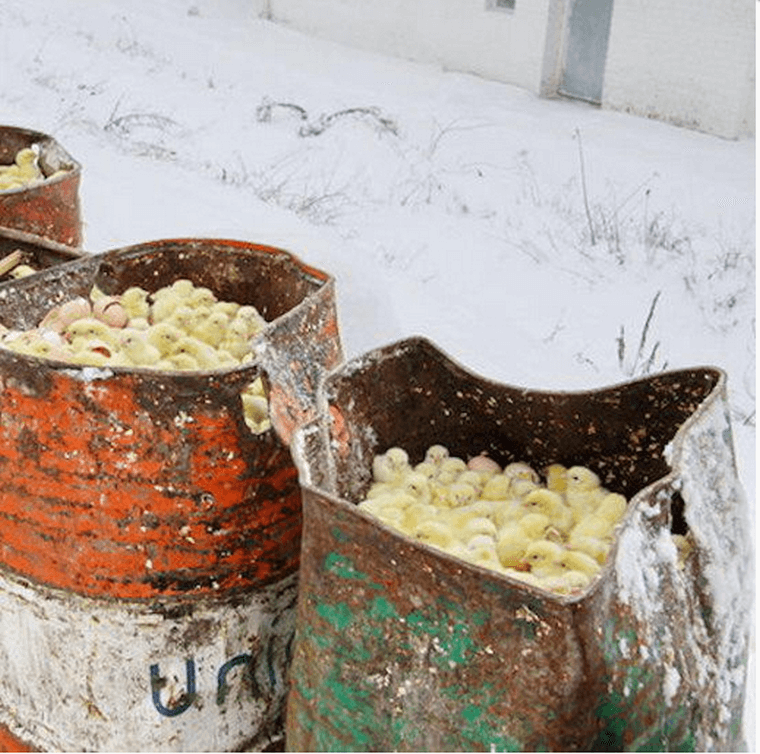The horrifying reality of the animal feed industry is that, with few exceptions, the ingredients used to make it are primarily derived from the waste materials left over from food manufactured for humans.
All the expired grocery store waste, slaughterhouse waste, poultry litter, liquified, decaying, rancid, and moldy garbage not considered fit for human consumption, is all conveniently diverted from one industry to another; from Nestle to Purina, fed to the animals that you eat. And the cycle begins again in a kind of circular madness that no one sees or fully comprehends.

CIRCULAR MADNESS
In fact, most animal feed and pet food companies are owned by multi-national conglomerates who make human food products, and they conveniently use the waste from food production and turn it into a profitable product for animals. But it’s not just livestock animals and domestic pets that suffer the abuses of industrial food and agriculture businesses, but if you eat meat, poultry or eggs, you are a participant in the cycle of abuse.

SYSTEMIC ABUSE OF ANIMALS
America’s livestock is fed a horrific concoction of animal feed ingredients which can include poultry litter, 4D livestock, USDA rejected and condemned meat and poultry, hatchery waste, roadkill, expired grocery store food and meat still wrapped in plastic and Styrofoam, all pulverized, ground and cooked through a process called rendering.

THE ORIGINAL RECYCLERS
The process of rendering has been around for centuries and was initially performed to make soap and candles. Simply put, rendering is what occurs when meat is boiled in water to separate fat and lard. But on today’s industrial level, rendering converts animal carcasses — tissue, bones, internal organs, hooves, blood, feathers, and hair — into dry meat by-products that are sold as animal feed and pet food ingredients.

Modern rendering today involves tossing animal carcasses into huge steam jacketed vessels; the carcasses are then ground, and cooked at temperatures of between 220 degrees and 270 degrees for twenty minutes to an hour to release fat and moisture. The tallow is removed and is the source of animal fat in most pet foods; the rest is percolated until fat is pressed out of the solids into “dry-rendered tankage.” The resulting product is ground further and then separated into fat, water, and fine solids by stages of centrifuging. The solids are pressed and dried and made into animal feed, commonly known as meat by-products and bone meal.

REPURPOSING WASTE
Tons of waste is diverted from landfills and on-farm losses to make animal feed, where food waste is fed to animals after it is heat treated and dehydrated and either mixed with dry feed or directly fed. Animal-feed manufacturers and farmers are essentially creating dehydrated food garbage from a vast array of diverse sources where fats emptied from restaurant fryers and grease traps, cement-kiln dust, newsprint and cardboard derived from plant cellulose, and even human sewage sludge are used to make food for animals.
OFFICIALLY APPROVED GARBAGE
As an example of what is legally allowed to be in animal feed, the following table is adapted from Official Publication of the American Animal Feed Control Association (AAFCO):
| RAW MATERIAL | EXAMPLES |
| Rendered animal protein from the slaughter of food production animals and other animals | Meat meal, meat meal tankage, meat and bone meal, poultry meal, animal by-product meal, dried animal blood, blood meal, feather meal, egg-shell meal, hydrolyzed whole poultry, hydrolyzed hair, bone marrow, and animal digest from dead, dying, diseased, or disabled animals including deer and elk |
| Animal waste | Dried ruminant waste, dried swine waste, dried poultry litter, and undried processed animal waste products |
| Marine by-products | Fish meal, fish residue meal, crab meal, shrimp meal, fish oil, fish liver and glandular meal, and fish by-products. |
| Restaurant food waste | Edible food waste from restaurants, bakeries, and cafeterias |
| Contaminated/adulterated food | Food adulterated with rodent, roach, or bird excreta that has been heat-treated to destroy pathogenic organisms |
| Plastics | Polyethylene roughage replacement |

Because these rendering plants serve as huge toxic waste dumps used to recycle animals into animal feed, what we currently have is a food system based on cannibalism, where cattle eat cattle, chickens eat chickens, and pigs eat pigs. Cattle are herbivorous creatures meant to eat grasses. And chickens naturally eat grass, weeds, bugs, and worms.
What kind of world is it that has accepted the systemic abuse of animals on a scale we cannot even begin to fathom?


Comments (5) Write a comment